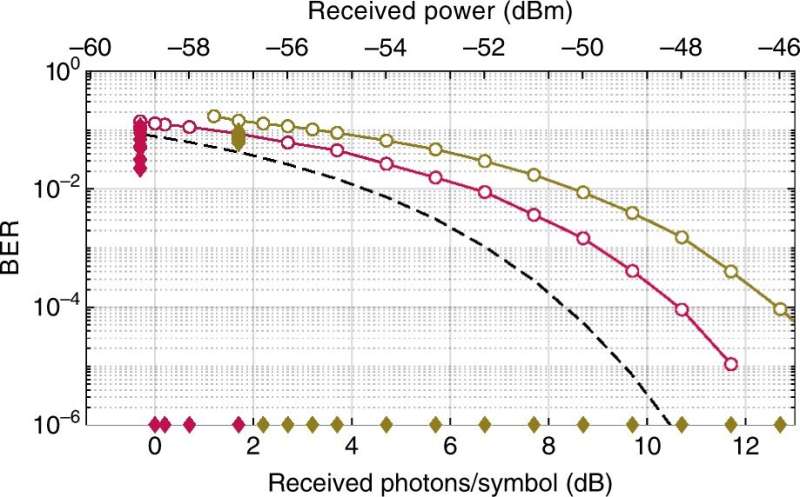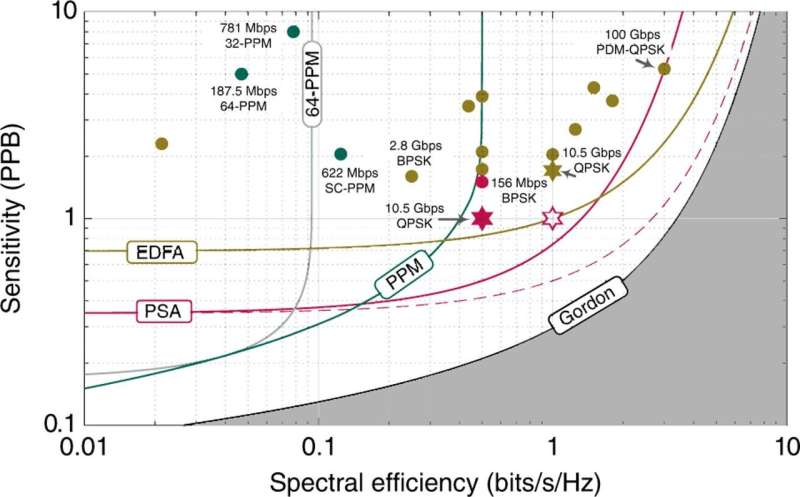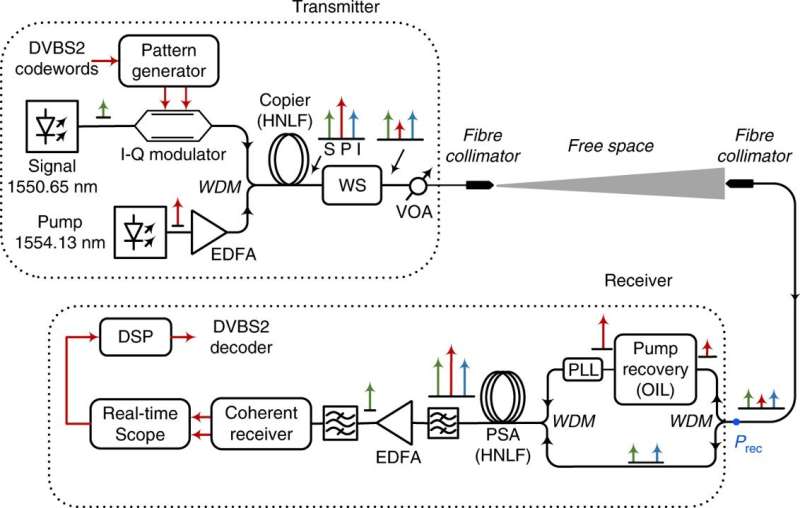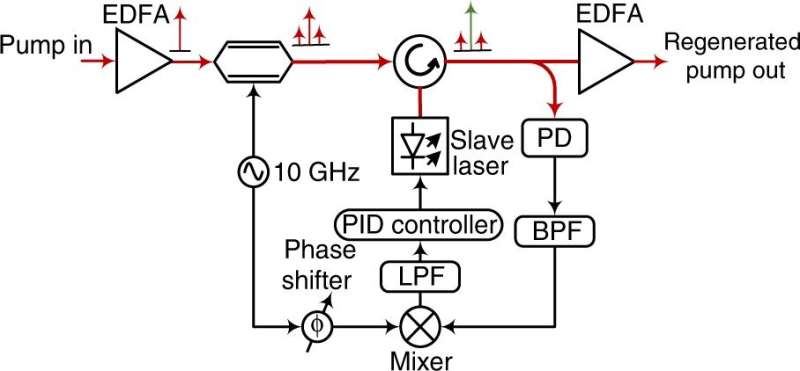September 17, 2020 feature
Space communication: developing a one photon-per-bit receiver using near-noiseless phase-sensitive amplification

During space-communication researchers require high-space intersatellite data transfer connectivity for deep-space missions while monitoring Earth. The technology is fundamentally influenced by available transmission power and the aperture size of receiver sensitivity. The transition from radio-frequency links to optical links is now under consideration due to its ability to significantly reduce the channel loss caused by diffraction during communication. In a widely used approach, researchers can develop power-efficient formats along with nanowire-based photon-counting receivers cooled to a few Kelvins to function at speeds below 1-Gigabytes per second (Gb/s). In order to achieve data transfer at data rates of multi-GB/s (as expected for future space applications) the systems will have to rely on pre-amplified receivers together with advanced signal generation and processing techniques, including fibre communications.
The sensitivity of such systems can be determined by the noise figure (NF—that measures the degradation of noise-to-signal ratio) of the pre-amplifier. Phase-sensitive optical amplifiers (PSA) promise to provide the best possible sensitivity for long-haul free-space links. In a new report now on Nature Light: Science & Applications, Ravikiran Kakarla and a team of scientists in photonics, microtechnology and nanoscience at the Chalmers University of Technology in Sweden developed a new approach using a phase-sensitive optical amplifier (PSA)-based receiver in a free-space transmission experiment. The team achieved an unprecedented bit-error free, black-box sensitivity of one photon per information bit (PPB) at an information rate of 10.5 Gb/s. While they only transmitted the signals across one meter during the study, they believe the outcomes will validate scaled-up communication across space.
Space exploration and satellite-borne sensors
Space exploration conducted by agencies such as NASA, ESA and JAXA, and their data output of satellite-borne sensors impose significant demands on communication systems to operate at higher data rates and reach further into space. The receiver sensitivity should be improved as an important step to enhance data throughput with as few photons received as possible. A better receiver sensitivity will allow longer reach, higher data throughput and the potential to use more compact optics. Common approaches currently in development to improve sensitivity suffer from a low spectral efficiency (SE) and can only achieve modest net data rates due to the trade-off between sensitivity and bandwidth.

For example, scientists widely consider pulse position modulation (PPM) during space communications since it can reach an excellent sensitivity at low signal-to-noise ratios (SNRs), however, the method can result in an ineffective spectral efficiency. As a result, they can employ photon counting receivers to receive pulse position modulation symbols and establish sensitivities of a few photons per bit. However, the resulting superconducting nanowire-based receivers need to be cooled to 2-4 Kelvin to function effectively. Future space communication systems will therefore need to exceed current speeds of function, which require major improvements beyond the existing receiver technology relative to the data rate and sensitivity. In this work, Kakarla et al. expanded on preceding work by including a theoretical analysis to achieve sensitivities with PSAs (phase-sensitive optical amplifiers). The work highlights the benefits of replacing current radiofrequency technologies with the more efficient optical systems to meet future demands of space communication with higher data rates to communicate across greater distances.

Experimental setup
The scientists used a free-space optical transmission link with a pre-amplified receiver. Since evolving space communication research has adopted technology from the optical fibre communication field, including techniques of advanced forward error correction (FEC), the scientists used a FEC-encoded binary data stream at the transmitter. They modulated the data onto the signal with quadrature-phase-shift keying (QPSK) for a resulting net information rate of 10.52 Gb/s. The team combined the signal with a continuous-wave pump to generate a conjugate idler wave containing the same information as the signal using four-wave mixing (FWM) in a nonlinear optical fibre.
The team amplified the signal, idler and pump waves to the desired output power and launched them into the free-space channel. They used the free-space link to confirm that no additional penalty occurred during the launch of waves into free space. The pump power used in the study was significantly lower than the combined signal and idler power, resulting in a nearly negligible power budget penalty.

Recovering a stable high-power
The team separated the pump waves at the receiver from the signal and idler waves using a wavelength division multiplexer, which they then recovered using optical injection locking – an optical and phase synchronization technique. After phase-sensitive amplification of the recovered wave, they filtered and detected the signal using a standard coherent receiver and a real-time oscilloscope for digital signal processing. The scientists measured a Bit Error Rate of the received signal to understand the performance of the PSA (phase-sensitive optical amplifier) based pre-amplified receiver. They compared the results with an erbium-doped fibre amplifier (EDFA) and the PSA performed better than the EDFA-based receiver. Using the experimental system, Kakarla et al. showed how error-free transmission could be achieved with a received power of 1-photon per information bit (PPB) to provide the best black-box receiver sensitivity reported to date.

Outcomes of the study for space communication
The described method is compatible with additional methods that use a different nonlinear platform to obtain improved sensitivity. The PSA approach represented a trade-off between spectral efficiency and sensitivity for receivers used in free-space communication, alongside experimental sensitivity records of using these techniques. While the demonstration focused on applications in deep-space links, they can also be used in atmospheric links to improve sensitivity. Such investigations will need to consider the effect of atmospheric turbulence on the PSA pre-amplified receiver.
In this way, Ravikiran Kakarla and colleagues presented a record black-box sensitivity of one photon per information bit at 10.5 Gb/s using a simple spectrally efficient format. They enabled the method using a phase-sensitive optical amplifier (PSA) approach and ultra-low power injection locking mechanism to achieve the observed sensitivity in the presence of a new noise-free, phase-sensitive pre-amplifier. The outcomes expect to increase the rate of information transmission, while reducing the size of the optics involved. These results can significantly contribute to space communication and in light detection and ranging (LIDAR) applications to monitor Earth.
More information: Ravikiran Kakarla et al. One photon-per-bit receiver using near-noiseless phase-sensitive amplification, Light: Science & Applications (2020). DOI: 10.1038/s41377-020-00389-2
Bryan S. Robinson et al. 781 Mbit/s photon-counting optical communications using a superconducting nanowire detector, Optics Letters (2006). DOI: 10.1364/OL.31.000444
Z. Tong et al. Towards ultrasensitive optical links enabled by low-noise phase-sensitive amplifiers, Nature Photonics (2011). DOI: 10.1038/nphoton.2011.79
Journal information: Light: Science & Applications , Optics Letters , Nature Photonics
© 2020 Science X Network




















